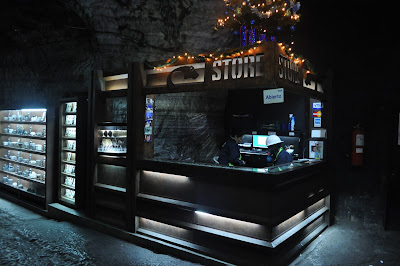In Colombia, if you want to know where to travel the best thing to do is ask Colombians. Every time we meet someone and tell them the general direction we are headed we get a short list of small towns and beautiful sights that we should visit in that particular area. These places are usually well off the gringo tourist trail and are sometimes even hard to find on the English version of Google.com.
This is exactly how we find ourselves in Paipa, Boyaca. And it is also exactly why we find ourselves doing the Ruta Navideña (Christmas Route) around the Boyaca region on December 21st. We have heard about this tour from several different Colombians. There are six routes to choose from and the buses leave around 6 PM, or when they get nine paying passengers. The tours stop at the main plazas of the tiny towns around Boyaca and we get between 20 minutes to an hour to soak up the lights and try local specialties. Our van is full early so we leave at 5:30 PM. We all get a festive, complimentary Blow Pop before heading off. Mika and I sit in front so we also get some good tidbits of information from the driver.
View Larger Map
Being quite cynical about the over-commercialization of Christmas in North America, I was a bit skeptical about how enjoyable this tour would be. I went into it with the attitude of "when in Rome...", but in the end it was really quite fun. We visited six tiny towns that we would have otherwise never considered going to (or would have never heard of). The towns' decorations ran the full spectrum from kitschy to classy.
Stop #1 - Santa Rosa A town famous for giving Simon Bolivar* a white horse during his campaign against the Spanish. As the first stop on the tour, Santa Rosa is worrisome. Around the main plaza are strange three dimensional models of animal scenes, biblical and Santa related. Nothing is really lit well and it's all a bit goofy.
 |
| Green cathedral of Santa Rosa |
 |
| A poor man's North Pole winter scene |
In all of these towns the main church is the largest building so when all lit up they stand alone strongly against the pitch black sky without any light interference from other big buildings.
 |
| Capilla and food cart |
 |
| A store on the main square |
Stop #4 - Busbanza This town really gave a half-hearted effort to their decorating (a lame duck mayor perhaps?). Or maybe Busbanza just happens to be the town between stops #3 and #5 so we pop by for a look. Our visit is saved by our nice chat with a family of women who came to the plaza this night wearing traditional dress and hand spinning wool.
Stop #5 - Corrales Corrales is the advertised highlight of the tour and does not disappoint. We are given an hour here to wander around and to try their region-famous tamales. By this time at night it is starting to get cold because we are over 2000 m (6500 ft) above sea level so having an herbal tea (aromatica) laced with aguardiente (anise flavored alcohol) hits the spot.
 |
| View of Corrales from the hill |
 |
| Tamalepalooza: Corrales' hearty tamales are stuffed with garbanzo beans, pork, beef and (not or) chicken |
Stop #6 - Nobsa By the final spot it is around 10:30 PM. I am quite tired and it is very cold outside. Nobsa's main square has two open air tents with dioramas. One is strangely a scene of the film Shrek and the second is like It's a Small World for the Boyaca region. We do not want to wait in line and just sneak peaks from the outside. We stay warm by visiting the shops around selling artisan goods.
 |
| Nobsa's cathedral |
 |
| It's a small town afterall |
* Simon Bolivar is the great general who led Colombia, Bolivia, Ecuador, Venezuela and Panama to independence. A guide referred to him as the George Washington of South America.
 |
| Oil painting by Ricardo Acevedo Bernal |


















































